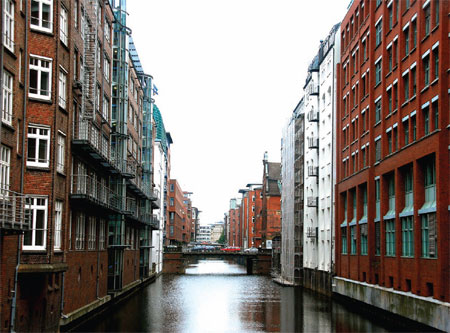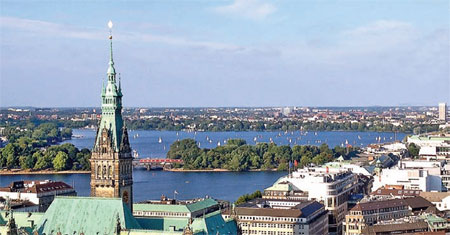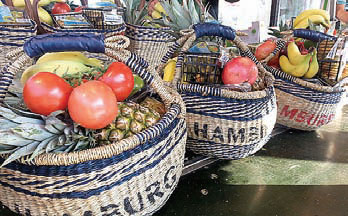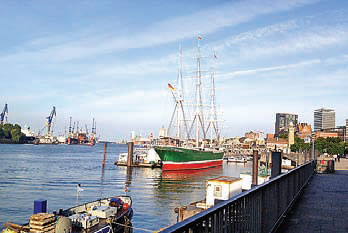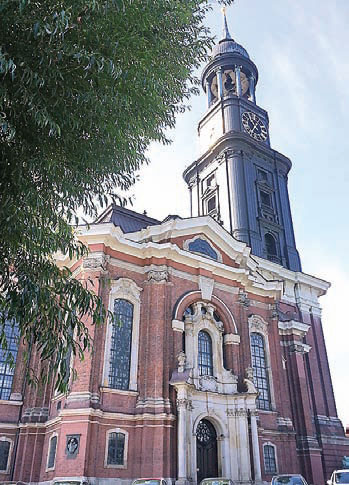Walking the streets of Hamburg
Updated: 2013-01-13 07:51
By Amber Wu Ping(China Daily)
|
|||||||
|
Canals flow between office and residential buildings in Germany's Hamburg, often called the "Venice of Northern Europe". Photos by Amber Wu Ping / for China Daily |
|
From St. Nikolai Memorial, visitors are rewarded by a stunning vista of Alster River and downtown Hamburg. |
|
Baskets of fruits are sold in the fish market. |
|
Ships from all over the world moor in the harbor, mixing with local ferries and barges. |
|
St. Pauli Church burned down in 1842, but was rebuilt through donations. |
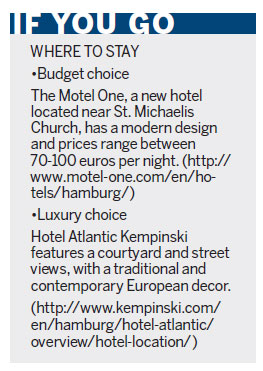
A stroll around Hamburg reveals a city with an interesting past and plenty to see and do. Amber Wu Ping takes a look around the harbor, churches and the infamous Reeperbahn.
Outside the plane window as we descended to Hamburg Airport I could spy a city surrounded by forests and it immediately felt like I was on holiday. There's plenty to see and do in Germany's second largest city, but all was quiet as I took a 15-minute stroll from my hotel to the harbor on an early Sunday morning.
The second largest port in Europe, situated on the Elbe River, spreads in front of me like a canvas. Ships from all over the world are gathered, mixing with local ferries and barges.
The fish auction hall and paintings in souvenir shops along the harbor are reminders of its past glories as a major trading center.
I spot people carrying baskets of fruit and fish and come across a market that is full of vendors selling small seafood hamburgers, snacks and flowers. It is packed with a mix of locals, tourists and night owls, who arrive after partying in the nearby red-light district of the Reeperbahn.
A few blocks away, canals weave among offices and residential buildings, which is why the city is oft called the "Venice of Northern Europe".
Another classic walking tour in Hamburg starts at the Rathaus, or City Hall.
After the old City Hall was destroyed by fire in 1842, it took almost 44 years to build a new one, at a cost of around 80 million euros ($104 million) in today's currency.
Stepping into this neo-Renaissance sandstone building, there are exhibitions detailing the development and history of the city.
The second floor still maintains its original governmental functions with Renaissance-style offices and meeting rooms for Hamburg's parliament and senate.
Meanwhile, in the city square, harbor and fish market, there are buskers everywhere and free concerts, making Hamburg a city of music.
On Sunday afternoon, I stumble upon a free rock concert where both the young and old enjoy the sunny weather, beer and music.
Walking south, I find myself surrounded by luxury boutiques and bustling shopping malls.
To the left of the bustling shopping area lies the beautiful Alster Lake, where I take a river cruise.
The captain and tour guide is obviously entertaining because everyone's laughing, though I can't understand much of what he's saying with my rudimentary German.
However, I'm equally entertained by the lively scenery outside the window, as locals take to their boats and even paddle surf.
Swans, ducks and geese bob on the blue water, lined by beautiful villas, where families barbecue or read in their courtyards.
Hamburg is the media capital of Germany. Walking to Baumwall after the cruise, there's a majestic ship-like building belonging to the publisher Gruner + Jahr (home to Stern and GEO magazine), part of Bertelsmann, the biggest media group in Europe.
Not far from G+J is St. Michaelis Church. It is the city's largest church and managed to survive the Allied bombings of World War II. The 132-meter high Baroque spire covered with copper has been a landmark for ships sailing up the river Elbe since it was constructed.
After stepping into a tiny elevator and climbing a twisting and seemingly endless staircase, I am rewarded with a beautiful panorama of the peaceful and elegant city, surrounded by lots of green trees.
My interest in Hamburg's history during World War II led me to St. Nikolai Memorial, a neo-Gothic church just 10 minutes walk from St. Pauli church.
The memorial shows an exhibition on the destruction of Hamburg. The church burned down during the fire of Hamburg in 1842 and was rebuilt through donations.
An elevator took us to the platform for an impressive view of Alster River and downtown Hamburg.
For a traditional German dinner after the tour, I head to Paulaner near St. Michaelis Church.
Although it's a pricey brand in China, it's reasonably priced in Germany. It has a great atmosphere with spacious outdoor seating.
We try various beers, ranging from non-alcoholic to dark and since I'm a big meat lover I particularly liked the traditional dish of pork knuckle with sauerkraut.
The Reeperbahn should not be missed, so I went on a pub crawl. We start our adventure at about 11 pm, when the bars and clubs, streets and alleys are already packed.
A friend informs me that reeperbahn means "rope street" in German, as hemp ropes used to be produced here for ships.
While the bars and clubs have a great atmosphere, the red-light area catering to the legalized sex industry is most eye-catching.
Strippers dance in the windows and though women are not allowed to enter, a male friend was encouraged to go in and came out asking: "Is 50 euros expensive for a woman?"
After dancing for a while at a club we grab doner kebabs, which is typical street food here due to the number of Turkish immigrants.
Another plus about Hamburg is its transport system, which gives quick and easy access to the city's beautiful and tranquil suburban areas.
Blankenese, a former fishing village along the Elbe River to the west of Hamburg, is now a posh neighborhood with an old world charm.
The steep hillside residences are beautifully designed and boast stunning river views, walking trails and stairs.
Locals relax on their rooftop gardens with a book or a telescope in their hands, while children play in the park. Along the waterfront, there is a small beach with outdoor cafes and restaurants - perfect hangouts on a sunny day.
Contact the writer at sundayed@chinadaily.com.cn.
(China Daily 01/13/2013 page16)
